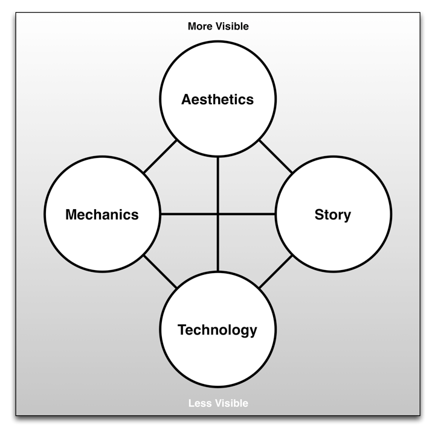The Elemental Tetrad
The Elemental Tetrad framework is presented in The Art Of Game Design: a Book of Lenses by Jesse Schell (Boca Raton, FL, CRC Press, 2008). This framework focuses on four elements.

Mechanics
Mechanics are the rules for interaction between the player and the game, they are what differentiate games from other non-interactive media.
Mechanics consist of
- Rules
- Objectives
- Other Formal elements
This is different from mechanics in MDA - Schell makes a distinction between mechanics and technology.
Aesthetics
Aesthetics describe how the game is perceived by the five senses
- Vision
- Sound
- Smell
- Taste
- Touch There are many different aspects of aesthetics - soundtrack, 3D graphics and animation, Packaging and cover art, etc.
Aesthetics here are different from aesthetics in MDA. MDA aesthetics describes the emotional response to the game, Schell’s aesthetics describe the five senses.
Technology
This refers to the underlying technology that makes the game work.
Digital technologies
- Computer and console hardware
- Software and programming
- Rendering software and pipelines Paper technologies
- Dice and other randomizers
- Statistics tables
Story
Story includes everything in Fullerton’s Dramatic Elements but also includes premise and character as well.
The Elemental Tetrad
Schell arranges the elements in a tetrad from most to least visible. The four elements also represent four groups in a game studio.
